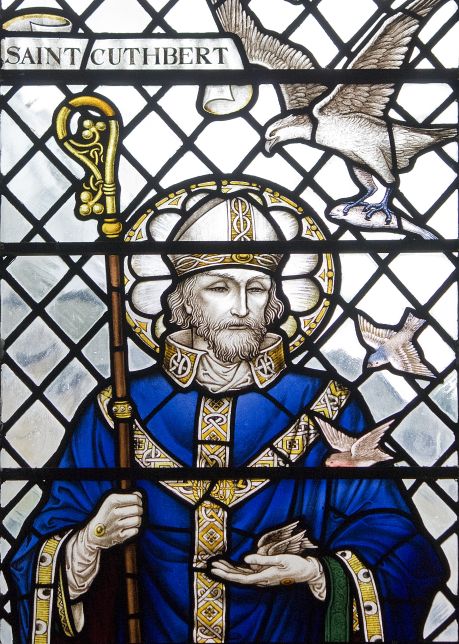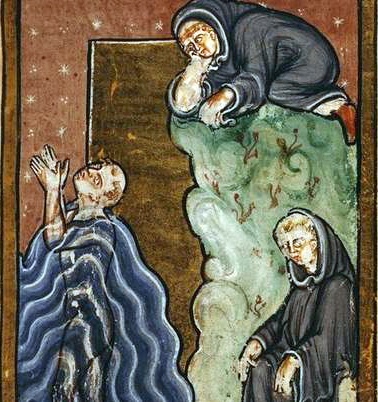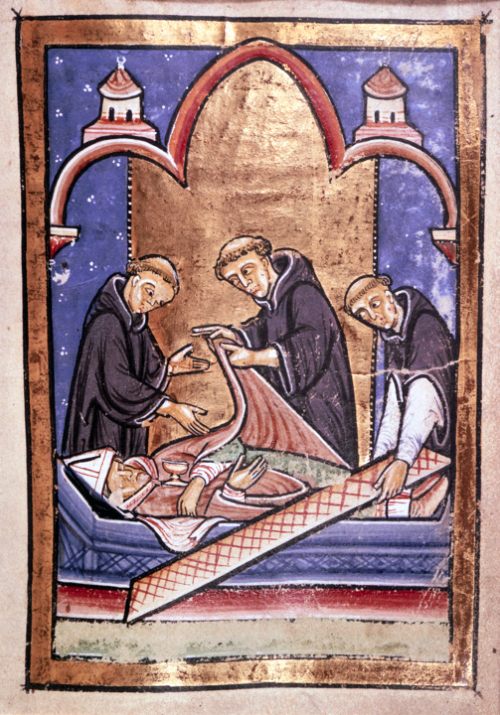Adapted from various sources, including Butler's Lives.
St. Cuthbert, Bishop of Lindisfarne († 687; Feast – March 20)
 When the Northumbrians, under the pious King Oswald, had embraced the Christian Faith with great fervor, the holy Bishop St. Aidan founded two monasteries –
that of Mailros (now Melrose), on the bank of the Tweed, and another on the island of Lindisfarne, afterwards called Holy Island. In both he established the rule of St. Columba;
he usually himself resided in the latter. St. Cuthbert was born not very far from Mailros, and in his youth was much edified by the devout deportment of the holy inhabitants
of that house, whose fervor in the service of God and the discharge of the duties of monastic life, he piously endeavored to imitate while keeping his fathers sheep in the mountains.
It happened one night that, while he was watching in prayer near his flock, as was his custom, he saw the soul of St. Aidan carried up to Heaven by angels – at that very instant
that holy man departed this life on the Isle of Lindisfarne. Serious reflections on the happiness of such a death determined the pious young man to repair to Mailros without delay,
where he received the monastic habit, whilst St. Eata was Abbot, and St. Boisil Prior. He studied the Holy Scriptures under the latter, and surpassed his brethren in fervor
in every monastic exercise.
When the Northumbrians, under the pious King Oswald, had embraced the Christian Faith with great fervor, the holy Bishop St. Aidan founded two monasteries –
that of Mailros (now Melrose), on the bank of the Tweed, and another on the island of Lindisfarne, afterwards called Holy Island. In both he established the rule of St. Columba;
he usually himself resided in the latter. St. Cuthbert was born not very far from Mailros, and in his youth was much edified by the devout deportment of the holy inhabitants
of that house, whose fervor in the service of God and the discharge of the duties of monastic life, he piously endeavored to imitate while keeping his fathers sheep in the mountains.
It happened one night that, while he was watching in prayer near his flock, as was his custom, he saw the soul of St. Aidan carried up to Heaven by angels – at that very instant
that holy man departed this life on the Isle of Lindisfarne. Serious reflections on the happiness of such a death determined the pious young man to repair to Mailros without delay,
where he received the monastic habit, whilst St. Eata was Abbot, and St. Boisil Prior. He studied the Holy Scriptures under the latter, and surpassed his brethren in fervor
in every monastic exercise.
Abbot Eata, being called to govern the new monastery of Rippon founded by King Alcfrid, took with him St. Cuthbert, and committed to him the care of entertaining
strangers – which charge is usually the most spiritually dangerous in the religious state. Cuthbert washed the feet of others, and served them with wonderful humility and meekness,
always remembering that Christ Himself is served in His members. He was most careful that the functions of Martha should never impair his spirit of recollection.
When St. Wilfrid was made Abbot of Rippon, St. Cuthbert returned with St. Eata to Mailros; and St. Boisil dying of the great pestilence in 664, he was chosen Prior in his place.
In this station, not content by word and example to form only his monks to perfect piety, he also labored assiduously among the people to withdraw them from
several heathen customs and superstitious practices which still remained among them. Parochial churches being at this time very scarce in the country, it was the custom
for the country people to flock about a priest or ecclesiastic, when he came into any village, for the sake of instruction; hearkening willingly to his words,
and more willingly practicing the good lessons he taught them. St. Cuthbert excelled all others by a most persuasive and moving eloquence; and such a brightness appeared
in his angelic face in delivering the word of God to the people, that none of them dared to conceal from him any part of their misbehavior. All laid their consciences
open before him, and endeavored by his injunctions and counsels to expiate the sins they had confessed, by worthy fruits of penance. He chiefly visited those villages
and hamlets at a distance – which being situated among high and craggy mountains, and inhabited by the most rustic, ignorant, and savage people, were the less frequented
by other preachers.
After St. Cuthbert had lived many years at Mailros, St. Eata – Abbot also of Lindisfarne – removed him to that larger monastery, and appointed him Prior.
By the perfect habit of mortification and prayer, the Saint had attained to so eminent a spirit of contemplation, that he seemed rather an angel than a man.
He often spent whole nights in prayer, and sometimes, to resist sleep, worked or walked about the island while he prayed. If he heard others complain that they had been
disturbed in their sleep, he used to say that he should think himself obliged to anyone that woke him from sleep, so that he might sing the praises of his Creator and labor for His honor.
His very countenance inflamed those who saw him to a love of virtue. He was so much addicted to compunction and inflamed with heavenly desires,
that he could never offer Mass without tears. He often moved penitents, who confessed to him, to abundant tears, by the torrents of his own which he shed for them.
His zeal in correcting sinners was always sweetened with tender charity and meekness.
The Saint had governed the monastery of Lindisfarne several years under his Abbot, when earnestly aspiring to a closer union with God,
he retired with his Abbot's consent to the little isle of Farne (image below), nine miles from Lindisfarne, there to lead an austere eremitical life.
The place was then uninhabited, and afforded him neither water, trees, nor grain. St. Cuthbert built himself a hut with a wall and trench about it,
and by his prayers obtained a well of fresh water within his cell. Having brought tools with him, he first sowed wheat, which failed; then barley, which,
though sown out of season, yielded a plentiful crop. He built a house at the entry of the island, to lodge the brethren who came to see him – whom he there met
and entertained with heavenly conferences. Afterwards he confined himself within his wall and trench, and gave spiritual advice only through a window,
without ever stirring out of his cell. He could not, however, refuse an interview with the holy Abbess and royal virgin Elfleda, who had been dedicated to God
from birth by her father, King Oswi, and who, in 680, succeeded St. Hilda in the government of the Abbey of Whitby. This meeting was held in the isle of Cocket,
then filled with holy anchorites. This close solitude was to our Saint an uninterrupted exercise of divine love, praised, and compunction, in which he enjoyed a
paradise of heavenly delights, unknown to the world.

In a synod of bishops held by St. Theodore at Twiford, in the Kingdom of Northumberland, it was resolved that St. Cuthbert should be raised to the
Episcopal See of Lindisfarne. But as neither letters nor messengers were of any force to obtain his consent to undertake the charge, King Egfrid,
who had been present at the council, and the holy Bishop Trumwin, with many others, sailed over to his island and conjured him on their knees not to refuse his labors,
which might be attended with so much advantage to souls. Their remonstrances were so pressing that the Saint could not refuse going with them, at least to the council,
but weeping most bitterly.
He received Episcopal consecration at York, the Easter following, from the hands of St. Theodore, assisted by six other bishops. In this new dignity the
Saint continued the practice of his former austerities; but remembering what he owed to his neighbor, he went about preaching and instructing with incredible fruit,
and without any intermission. He made it everywhere his particular care to exhort, feed, and protect the poor. By divine revelation he saw and mentioned to others,
at the very instant that it happened, the overthrow and death of King Egfrid at the hands of the Picts, in 685. He cured the wife of a noble Thane, who lay speechless
and senseless at the point of death, by use of water which he had blessed, as well as many others. For his miracles, he was called the Thaumaturgus (wonder-worker)
of Britain. But the most wonderful of his miracles was that which grace wrought in him by the perfect victory which it gave him over his passions.
 His zeal for justice was most ardent; but nothing seemed ever to disturb the peace and serenity of his mind. By the close union of his soul with God,
Whose will alone he sought and considered in all things, he overlooked all temporal events, and under all accidents his countenance was always cheerful, always the same –
particularly in bearing all bodily pains and every kind of adversity with joy. Prayer was his center; his brethren discovered sometimes he spent three or four nights
together in that heavenly exercise, allowing himself little or no sleep. When St. Ebba the royal virgin, sister to the kings St. Oswald and Oswi, Abbess of the double
monastery of Coldingham, invited him to edify that house by his exhortations, he complied and stayed there some days. In the night, whilst others were asleep,
he stole out to his devotions according to his custom in other places. One of the monks who watched and followed him one night, found that the Saint, going down to the seashore,
went into the water nearly up to his shoulders, and there sang praises to God. In this manner he passed the silence of the night. Before the break of day,
he came out and having prayed awhile on the sands (to dry himself), returned to the monastery and was ready to join in morning Lauds.
His zeal for justice was most ardent; but nothing seemed ever to disturb the peace and serenity of his mind. By the close union of his soul with God,
Whose will alone he sought and considered in all things, he overlooked all temporal events, and under all accidents his countenance was always cheerful, always the same –
particularly in bearing all bodily pains and every kind of adversity with joy. Prayer was his center; his brethren discovered sometimes he spent three or four nights
together in that heavenly exercise, allowing himself little or no sleep. When St. Ebba the royal virgin, sister to the kings St. Oswald and Oswi, Abbess of the double
monastery of Coldingham, invited him to edify that house by his exhortations, he complied and stayed there some days. In the night, whilst others were asleep,
he stole out to his devotions according to his custom in other places. One of the monks who watched and followed him one night, found that the Saint, going down to the seashore,
went into the water nearly up to his shoulders, and there sang praises to God. In this manner he passed the silence of the night. Before the break of day,
he came out and having prayed awhile on the sands (to dry himself), returned to the monastery and was ready to join in morning Lauds.
St. Cuthbert, foreseeing his death was approaching, resigned his bishopric which he had held for two years, and retired to his solitude on Farne Island,
to prepare himself for his last passage. Two months later he fell sick, and permitted Herefrid, the Abbot of Lindisfarne, who came to visit him, to leave two monks to
attend him in his last moments. He received the Viaticum of the Body and Blood of Christ from the hands of the Abbot, at the hour of midnight prayer,
and immediately lifting up his eyes and stretching out his hands, sweetly fell asleep in Christ on the 20th of March, 687. According to his desire, his body was buried
at the Monastery of St. Peter in Lindisfarne, on the right side of the high altar. St. Bede relates many miracles performed at his tomb; and adds that eleven years
after his death the monks exhuming his body, instead of the dust they expected, found him incorrupt, with the joints pliable and the clothes fresh and entire.
They put him into a new coffin, placed above the pavement over the former grave; several miracles were wrought there, some even by the mere touching of the cloths covering the coffin.
 In the Danish invasions, the monks carried the body away from Lindisfarne (image below); and after several removals on the continent,
settled with their treasure on a woody hill almost surrounded by the River Were, formed by nature as a place of defense. Dunelm, or Durham, signifies a hill upon waters,
from the Saxon words Dun – a hill, and Holme – a place in or among waters. They built there a church of stone, dedicated in 995, and placed in it the body of
St. Cuthbert with great solemnity, transferring to that place his episcopal see. William of Malmesbury writes that the body was again found incorrupt (image left)
and publicly shown at Durham, 415 years after the first exhumation. Many princes enriched exceedingly the new monastery and cathedral, in honor of St. Cuthbert.
The great King Alfred, who honored St. Cuthbert as his particular patron and ascribed to his intercession some of his greatest victories and other blessings,
was a special benefactor of this church.
In the Danish invasions, the monks carried the body away from Lindisfarne (image below); and after several removals on the continent,
settled with their treasure on a woody hill almost surrounded by the River Were, formed by nature as a place of defense. Dunelm, or Durham, signifies a hill upon waters,
from the Saxon words Dun – a hill, and Holme – a place in or among waters. They built there a church of stone, dedicated in 995, and placed in it the body of
St. Cuthbert with great solemnity, transferring to that place his episcopal see. William of Malmesbury writes that the body was again found incorrupt (image left)
and publicly shown at Durham, 415 years after the first exhumation. Many princes enriched exceedingly the new monastery and cathedral, in honor of St. Cuthbert.
The great King Alfred, who honored St. Cuthbert as his particular patron and ascribed to his intercession some of his greatest victories and other blessings,
was a special benefactor of this church.
When the shrine of the Saint was plundered and demolished by the order of Henry VIII, the body of St. Cuthbert, which was again found incorrupt –
as Harpsfield testifies – met with greater regard than many others; for it was not burned, as were those of St. Edmund, King and Martyr, St. Thomas Becket, and many others.
After the King's officers had carried away the plunder of his shrine, the body of St. Cuthbert was privately buried under the place where the shrine stood, though the spot is unknown.
His sapphire ring was given by Lord Viscount Montaigne to the Bishop of Chalcedon, Richard Smith, who had long been sheltered from the persecution in the house of that nobleman.
Bishop Smith relates, in his Life of Margaret, Lady Montaigne, that Queen Elizabeth, out of her singular regard for this lady, from the time she had been lady of honor
in the court of Queen Mary and King Philip, tacitly granted her house a kind of privilege, by never allowing it to be searched on account of religious persecution;
so that sometimes as many as sixty priests were hidden in it. Bishop Smith, in turn, left the ring to the monastery of English canonesses at Paris, which also possesses a tooth
of the Saint.
The life of St. Cuthbert was almost a continual prayer. There was no business, no company, no place however public, which did not afford him an opportunity,
and even a fresh motive to pray. Not content to pass the day in this exercise, he continued it constantly for several hours of the night, which was to him a time of light
and interior delights. Whatever he saw seemed to speak to him of God, and to invite him to His love. His conversation was on God and heavenly things, and he would have
regretted a single moment, which had not been employed with God or for His honor, as utterly lost. The inestimable riches which he found in God showed him how precious
every moment is in which he had it in his power to enjoy the divine converse. The immensity of God, Who is present in us and in all creatures, and whom millions of worlds
cannot confine or contain; His eternity, to which all time coexists, and which has neither beginning, end, nor succession; the unfathomed abyss of His judgments; the sweetness
of His providence; His adorable sanctity; His justice, wisdom, goodness, mercy, and love, especially as displayed in the wonderful mystery of the Incarnation, and in the doctrine,
actions, and sufferings of our Blessed Redeemer – in a word, all the incomprehensible attributes of the Divinity, successively filled the Saint’s mind and heart,
and kindled in his soul the most sweet and ardent affections. For holy contemplation discovers to a soul a new and most wonderful world, whose beauty, riches,
and pure delights astonish and transport her out of herself. St. Teresa, coming from prayer, said she came from a world greater and more beautiful beyond comparison,
than a thousand worlds, like that which we behold with our corporal eyes, could be.

Back to "In this Issue"
Back to Top
Back to Saints
Alphabetical Index; Calendar List of Saints
Contact us: smr@salvemariaregina.info
Visit also: www.marienfried.com


 When the Northumbrians, under the pious King Oswald, had embraced the Christian Faith with great fervor, the holy Bishop St. Aidan founded two monasteries –
that of Mailros (now Melrose), on the bank of the Tweed, and another on the island of Lindisfarne, afterwards called Holy Island. In both he established the rule of St. Columba;
he usually himself resided in the latter. St. Cuthbert was born not very far from Mailros, and in his youth was much edified by the devout deportment of the holy inhabitants
of that house, whose fervor in the service of God and the discharge of the duties of monastic life, he piously endeavored to imitate while keeping his fathers sheep in the mountains.
It happened one night that, while he was watching in prayer near his flock, as was his custom, he saw the soul of St. Aidan carried up to Heaven by angels – at that very instant
that holy man departed this life on the Isle of Lindisfarne. Serious reflections on the happiness of such a death determined the pious young man to repair to Mailros without delay,
where he received the monastic habit, whilst St. Eata was Abbot, and St. Boisil Prior. He studied the Holy Scriptures under the latter, and surpassed his brethren in fervor
in every monastic exercise.
When the Northumbrians, under the pious King Oswald, had embraced the Christian Faith with great fervor, the holy Bishop St. Aidan founded two monasteries –
that of Mailros (now Melrose), on the bank of the Tweed, and another on the island of Lindisfarne, afterwards called Holy Island. In both he established the rule of St. Columba;
he usually himself resided in the latter. St. Cuthbert was born not very far from Mailros, and in his youth was much edified by the devout deportment of the holy inhabitants
of that house, whose fervor in the service of God and the discharge of the duties of monastic life, he piously endeavored to imitate while keeping his fathers sheep in the mountains.
It happened one night that, while he was watching in prayer near his flock, as was his custom, he saw the soul of St. Aidan carried up to Heaven by angels – at that very instant
that holy man departed this life on the Isle of Lindisfarne. Serious reflections on the happiness of such a death determined the pious young man to repair to Mailros without delay,
where he received the monastic habit, whilst St. Eata was Abbot, and St. Boisil Prior. He studied the Holy Scriptures under the latter, and surpassed his brethren in fervor
in every monastic exercise.
 His zeal for justice was most ardent; but nothing seemed ever to disturb the peace and serenity of his mind. By the close union of his soul with God,
Whose will alone he sought and considered in all things, he overlooked all temporal events, and under all accidents his countenance was always cheerful, always the same –
particularly in bearing all bodily pains and every kind of adversity with joy. Prayer was his center; his brethren discovered sometimes he spent three or four nights
together in that heavenly exercise, allowing himself little or no sleep. When St. Ebba the royal virgin, sister to the kings St. Oswald and Oswi, Abbess of the double
monastery of Coldingham, invited him to edify that house by his exhortations, he complied and stayed there some days. In the night, whilst others were asleep,
he stole out to his devotions according to his custom in other places. One of the monks who watched and followed him one night, found that the Saint, going down to the seashore,
went into the water nearly up to his shoulders, and there sang praises to God. In this manner he passed the silence of the night. Before the break of day,
he came out and having prayed awhile on the sands (to dry himself), returned to the monastery and was ready to join in morning Lauds.
His zeal for justice was most ardent; but nothing seemed ever to disturb the peace and serenity of his mind. By the close union of his soul with God,
Whose will alone he sought and considered in all things, he overlooked all temporal events, and under all accidents his countenance was always cheerful, always the same –
particularly in bearing all bodily pains and every kind of adversity with joy. Prayer was his center; his brethren discovered sometimes he spent three or four nights
together in that heavenly exercise, allowing himself little or no sleep. When St. Ebba the royal virgin, sister to the kings St. Oswald and Oswi, Abbess of the double
monastery of Coldingham, invited him to edify that house by his exhortations, he complied and stayed there some days. In the night, whilst others were asleep,
he stole out to his devotions according to his custom in other places. One of the monks who watched and followed him one night, found that the Saint, going down to the seashore,
went into the water nearly up to his shoulders, and there sang praises to God. In this manner he passed the silence of the night. Before the break of day,
he came out and having prayed awhile on the sands (to dry himself), returned to the monastery and was ready to join in morning Lauds. In the Danish invasions, the monks carried the body away from Lindisfarne (image below); and after several removals on the continent,
settled with their treasure on a woody hill almost surrounded by the River Were, formed by nature as a place of defense. Dunelm, or Durham, signifies a hill upon waters,
from the Saxon words Dun – a hill, and Holme – a place in or among waters. They built there a church of stone, dedicated in 995, and placed in it the body of
St. Cuthbert with great solemnity, transferring to that place his episcopal see. William of Malmesbury writes that the body was again found incorrupt (image left)
and publicly shown at Durham, 415 years after the first exhumation. Many princes enriched exceedingly the new monastery and cathedral, in honor of St. Cuthbert.
The great King Alfred, who honored St. Cuthbert as his particular patron and ascribed to his intercession some of his greatest victories and other blessings,
was a special benefactor of this church.
In the Danish invasions, the monks carried the body away from Lindisfarne (image below); and after several removals on the continent,
settled with their treasure on a woody hill almost surrounded by the River Were, formed by nature as a place of defense. Dunelm, or Durham, signifies a hill upon waters,
from the Saxon words Dun – a hill, and Holme – a place in or among waters. They built there a church of stone, dedicated in 995, and placed in it the body of
St. Cuthbert with great solemnity, transferring to that place his episcopal see. William of Malmesbury writes that the body was again found incorrupt (image left)
and publicly shown at Durham, 415 years after the first exhumation. Many princes enriched exceedingly the new monastery and cathedral, in honor of St. Cuthbert.
The great King Alfred, who honored St. Cuthbert as his particular patron and ascribed to his intercession some of his greatest victories and other blessings,
was a special benefactor of this church.
